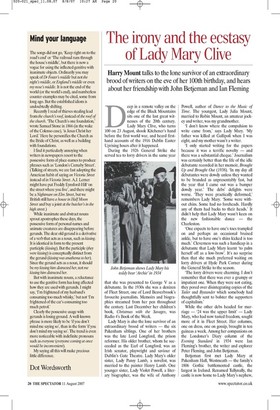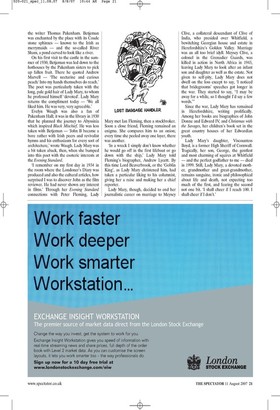The irony and the ecstasy of Lady Mary Clive Harry
Mount talks to the lone survivor of an extraordinary brood of writers on the eve of her 100th birthday, and hears about her friendship with John Betjeman and Ian Fleming Deep in a remote valley on the edge of the Black Mountains sits one of the last great witnesses of the 20th century. Lady Mary Clive, who turns 100 on 23 August, shook Kitchener's hand before the first world war, and heard firsthand accounts of the 1916 Dublin Easter Uprising hours after it happened.
During the 1926 General Strike she served tea to lorry drivers in the same year that she was presented to George V as a debutante. In the 1930s she was a denizen of Fleet Street, one of Lord Beaverbrook's favourite journalists. Memoirs and biographies streamed from her pen throughout the century. Last December her children's book, Christmas with the Savages, was Radio 4's Book of the Week.
Lady Mary is also the lone survivor of an extraordinary brood of writers — the six Pakenham siblings. One of her brothers was the late Lord Longford, the prison reformer. His older brother, whom he succeeded as the Earl of Longford, was an Irish senator, playwright and saviour of Dublin's Gate Theatre. Lady Mary's older sister, Lady Pansy Lamb, a novelist, was married to the painter Henry Lamb. One younger sister, Lady Violet Powell, a literary biographer, was the wife of Anthony Powell, author of Dance to the Music of Time. The youngest, Lady Julia Mount, married to Robin Mount, an amateur jockey and writer, was my grandmother.
'I don't know where the compulsion to write came from,' says Lady Mary. 'My father was killed at Gallipoli when I was eight, and my mother wasn't a writer.
'I only started writing for the papers because it was a terrific novelty — and there was a substantial cheque.' Journalism was certainly better than the life of the idle debutante recorded in her memoir, Brought Up and Brought Out (1938). 'In my day all debutantes were dowdy unless they wanted to be branded as unpresentably fast, but the year that I came out was a bumper dowdy year.' The debs' delights were worse. 'They were practically deformed,' remembers Lady Mary. 'Some were without chins. Some had no foreheads. Hardly any of them had backs to their heads.' It didn't help that Lady Mary wasn't keen on the new fashionable dance — the Charleston.
'One expects to have one's toes trampled on and perhaps an occasional bruised ankle, but to have one's shins kicked is too much.' Cleverness was such a handicap in a debutante that Lady Mary learnt 'to palm herself off as a low-brow'. It's no surprise then that she much preferred waiting on lorry drivers at Hyde Park Corner during the General Strike to the season.
'The lorry drivers were charming. I don't remember that there was ever a grumpy or impatient one. When they were not eating, they pored over disintegrating copies of the Tatler and Bystander which somebody had thoughtfully sent to bolster the supporters of capitalism.'
While the other debs headed for marriage — '24 was the upper limit' — Lady Mary, who had now tasted freedom, sought more of it in Fleet Street. Her columns, one on dress, one on gossip, brought in ten guineas a week. Among her companions on the Londoner's Diary column of the Evening Standard in 1934 were Ian Fleming's brother, the writer and explorer Peter Fleming, and John Betjeman.
Betjeman first met Lady Mary at Pakenham Hall, Westmeath — the family's 1806 Gothic battlemented castle, the largest in Ireland. Renamed Tullynally, the castle is now home to Lady Mary's nephew, the writer Thomas Pakenham. Betjeman was enchanted by the place with its Coade stone sphinxes — known to the Irish as merrymaids — and the so-called River Sham, a pond curved to look like a river.
On his first visit to the castle in the summer of 1930, Betjeman was led down to the hothouses by the Pakenham sisters to pick up fallen fruit. There he quoted Andrew Marvell — 'The nectarine and curious peach/ Into my hands themselves do reach.' The poet was particularly taken with the long, pale gold hair of Lady Mary, to whom he professed himself 'devoted'. Lady Mary returns the compliment today — 'We all liked him He was very, very agreeable.'
Evelyn Waugh was also a fan of Pakenham Hall; it was in the library in 1930 that he planned the journey to Abyssinia which inspired Black Mischief. He was less taken with Betjeman — 'John B became a bore rather with Irish peers and revivalist hymns and his enthusiasm for every sort of architecture,' wrote Waugh. Lady Mary was a bit taken aback, then, when she bumped into this poet with the esoteric interests at the Evening Standard.
'I remember on my first day in 1934 in the room where the Londoner's Diary was produced and also the cultural articles, how surprised I was to discover John as the film reviewer. He had never shown any interest in films.' Through her Evening Standard connections with Peter Fleming, Lady Mary met Ian Fleming, then a stockbroker. Soon a close friend, Fleming remained an enigma. She compares him to an onion; every time she peeled away one layer, there was another.
'In a wreck I simply don't know whether he would go off in the first lifeboat or go down with the ship,' Lady Mary told Fleming's biographer, Andrew Lycett. By this time Lord Beaverbrook, or the 'Goblin King', as Lady Mary christened him, had taken a particular liking to his columnist, giving her a raise and making her a chief reporter.
Lady Mary, though, decided to end her journalistic career on marriage to Meysey Clive, a collateral descendant of Clive of India, who presided over Whitfield, a bewitching Georgian house and estate in Herefordshire's Golden Valley. Marriage was an all too brief idyll. Meysey Clive, a colonel in the Grenadier Guards, was killed in action in North Africa in 1943, leaving Lady Mary to look after an infant son and daughter as well as the estate. Not given to self-pity, Lady Mary does not dwell on the loss except to say, 'I noticed that bridegrooms' speeches got longer in the war. They started to say, "I may be away for a while, so I thought I'd say a few words."
Since the war, Lady Mary has remained in Herefordshire, writing prolifically. Among her books are biographies of John Donne and Edward IV, and Christmas with the Savages, her children's book set in the great country houses of her Edwardian youth.
Lady Mary's daughter, Viscountess Boyd, is a former High Sheriff of Cornwall. Tragically, her son, George, the gentlest and most charming of squires at Whitfield — and the perfect godfather to me — died in 1999. Still, Lady Mary, a devoted mother, grandmother and great-grandmother, remains sanguine, ironic and philosophical about life and death, not expecting too much of the first, and fearing the second not one bit. 'I shall cheer if I reach 100. I shall cheer if I don't.'










































 Previous page
Previous page